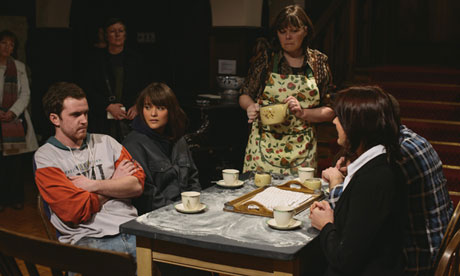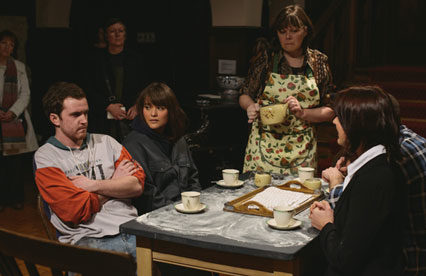Gary Raymond reviews Tir Sir Gar from Theatr Genedlaethol Cymru in collaboration with Marc Rees at Carmarthen County Museum.

at Carmarthen County Museum
Theatr Genedlaethol Cymru
Artistic Director: Marc Rees
Written by Roger Williams
The play is the thing, to quote one famous bereaved theatrical son, and in this new collaboration between Theatr Genedlaethol Cymru, artist Marc Rees and playwright Roger Williams, it is most definitely the thing. A Welsh-language multi-media theatrical event that takes as its theme the erosion of the traditions of agricultural communities, Tir Sir Gar is a complex balancing act between fact and fiction, and between emotional, involving drama and cold introspective installation art. The balance is delicate, sometimes successful and sometimes not.
Granted, the story would not be enough on its own: the head of the table dies and the widow and offspring go through the mill, as it were, as they try to decide on the future of the dairy farm. Emmerdale recently ran the same story. But the strength here is in the superb acting that the cast bring Williams’ very good script, a script that has the confidence to open up the drama so it is clear that, although we are in Wales, and we are in now, we are actually in the plight of the working classes, yet again. The farm produce is driven to Crewe and back before the farmhands themselves can actually purchase it in the local supermarket (managed by daughter Luned). But this is the plight of rural communities the world over, from the cork farmers of Portugal to Argentine gauchos. This broad universal brushstroke is the strength, also, of many of the installation videos that the audience are led to in between acts. They are solemn and reflective at best. But at their worst, and too often, they seem to have bent over backwards to make artsy the very spit and gristle that this show is supposed to be celebrating and rescuing. The films are sometimes in danger of obfuscating the message.
And what is that message? It appears to be that ‘times change’ and ‘that is bad’. Well, the mechanics of changing times may be good material for drama – and it proves to be here – but you need to go further to make it a convincing lecture. The message of Tir Sir Gar seemed quite short.
The central drama is a good one, the characters solidly crafted to type, and although it is, for the main, much indebted to Osborne for the craft of its highly emotional interplay, for its silences as well as its outbursts, it is bold enough to evoke moments of Beckettian verbals to keep you on your toes. Sion Ifan stands out as the son who stayed at home, Arwel, brimming with resentment and bottle-capped affection; Catherine Ayers is excellent as Luned, the daughter caught between the two worlds of her family’s traditions and the modern ‘evils’ of corporate hegemony. But there is a problem here; when Luned’s mother scowls that the supermarket she manages is not a shop but a ‘shed’, we are reminded of the Dutch-barn where the evening started, and we are forced to wonder if modernism is not only entwined with inevitability, but if it’s also simply a colder repetition of patterns. These are the most profound questions that the play raises and then, too often, walks away from.
The stage is the Carmarthenshire County Museum, a place the audience is forewarned is under real threat, just as is Pencerig Farm, the place within the place, where the fictional drama will be set. The grey gas of modernity is all about us, even within the walls of fiction as it kicks and scratches to get out and join us in reality. The problem here is that, no matter how well-intentioned the message – and it is an important one – the focus on the central drama is often undermined by the interjection of the authorial voice – the curatorial voice, even – reminding us that we all have a price to pay, as well as a responsibility, in the denudation of our traditions.
Tir Sir Gar has flashes of theatre at its most moving, and suggests moments when the conversation might really take flight. But there are no remedies on offer. It is an admirably ambitious attempt at tackling an old subject in a new way, muddied by the clutter on the peripheries of the main drama. The play is the thing, the rest could have been left behind.
You might also like…
Gary Raymond found little to write home about National Theatre Wales’s On Bear Ridge. It cannot be denied the buzz around it in some quarters is telling of a wider political movement.
Gary Raymond is editor at Wales Arts Review. His latest novel, The Golden Orphans is available now.



 Enjoyed this article? Support our writers directly by buying them a coffee and clicking this link.
Enjoyed this article? Support our writers directly by buying them a coffee and clicking this link.








